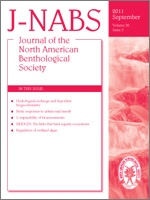Interest in the biodiversity value of urban waters is growing. Understanding key ecological processes is essential for effective management of these aquatic ecosystems. Our paper focuses on identifying the key factors that structure chironomid assemblages, such as water quality and dredging, in urban waters strongly influenced by seepage of large rivers. Chironomid assemblages were studied in urban surface-water systems (man-made drainage ditches) in polder areas along lowland reaches of the rivers Rhine–Meuse in The Netherlands. Multivariate analysis was used to identify the key environmental factors. Taxon richness, Shannon index (H′), rareness of species, and life-history strategies at urban locations were compared with available data from similar man-made water bodies in rural areas, and the effectiveness of dredging for restoring chironomid diversity in urban waters was tested. Three different chironomid associations were distinguished by Two-Way Indicator Species Analysis. Variation within and among chironomid associations were significantly related to substrate (sludge layer and substrate type: sand vs clay), % cover of lemnids, submerged vegetation, filamentous algae, and water transparency. Chironomid taxon richness and H′ were similar in urban and rural waters, probably because of their similar hydrologic, morphologic, and water-quality conditions and their similar dredging and weed-control regimes. Rareness was slightly higher in urban than in rural waters. In urban water systems, chironomid taxon richness was negatively related to sludge layer and % cover of lemnids. Dredging changed chironomid species composition, and increased taxon richness and life-history strategies indicative of good O2 conditions. Therefore, dredging can be regarded as an effective measure to restore diversity of chironomid communities in urban waters affected by nutrient-rich seepage or inlet of river water.
How to translate text using browser tools
4 October 2011
The influence of environmental factors and dredging on chironomid larval diversity in urban drainage systems in polders strongly influenced by seepage from large rivers
K Vermonden,
K. P Brodersen,
D Jacobsen,
H van Kleef,
G van der Velde,
R. S. E. W Leuven
ACCESS THE FULL ARTICLE
It is not available for individual sale.
This article is only available to subscribers.
It is not available for individual sale.
It is not available for individual sale.
biodiversity
ditches
Eutrophication
life-history strategies
macroinvertebrates
non-biting midges
rehabilitation





